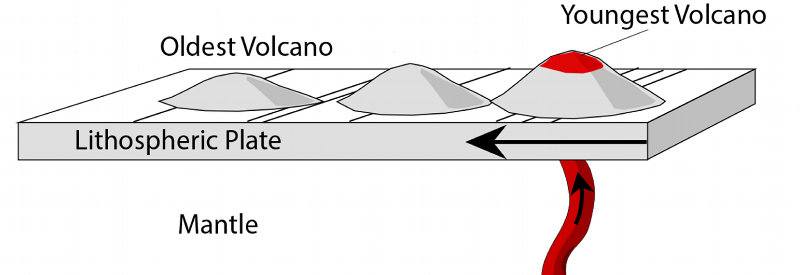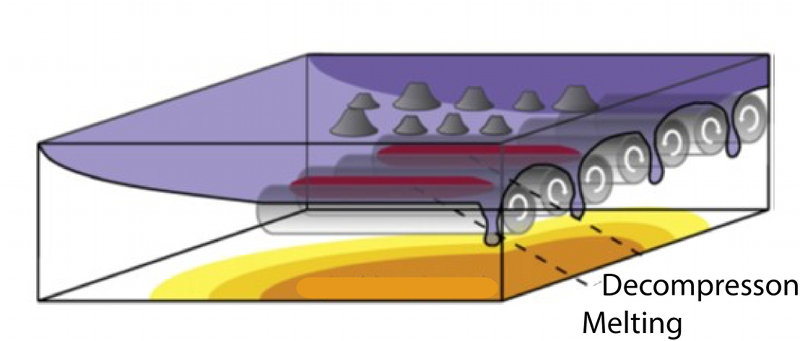
By Del Bohnenstiehl - North Carolina State University

Figure 1. Regional view of western Pacific bathymetry showing distribution of linear volcanic chains. Image generated using GeoMapApp. Download larger version (jpg, 671 KB).
The western Pacific seafloor hosts numerous seamounts rising thousands of meters above the depths of the abyssal plains. These undersea volcanoes, which are often organized into linear chains of anomalously shallow topography, erupted long after the initial formation of the Pacific plate (Figure 1).

Figure 2. Hotspot model for linear island formation. Age progressive volcanism is generated as the lithospheric plate passes of a plume source originating from in the mantle. Image courtesy Bruce Railsback (UGA). Download larger version (jpg, 637 KB).
The classic model for the formation of these volcanoes is that of a "hotspot," in which plumes of hot mantle rock, perhaps originating as deep as the core and mantle boundary (~2,900 kilometer), rise buoyantly. This upward transport of material reduces the confining pressure and results in a small of amount of melt being generated. This melt may migrate into the overlying plate and later erupt on the seafloor. As the plate moves laterally across this hotspot, a linear chain of volcanoes is created with the oldest lavas located downstream and the youngest lavas being erupted above the plume.
While this theory successfully explains the linear relationship between age and distance within some long-lived volcanic chains (e.g., the Samoan and Hawaiian Islands) it does not give an explanation for the temporal and spatial pattern of volcanism within others (e.g., Cook-Australs, Marshalls, Gilberts, and Line Islands). This has lead some researchers to abandon the hotspot plume theory altogether. Others invoke a variety of non-hotspot mechanisms in an attempt to explain the broader spectrum of volcanism occurring within a plate.
For example, volcanic chains might also arise in the interior of a plate due to extension and cracking of the lithosphere (Figure 3). The forces exerted on the plate by thermal cooling and plate tectonics can create new pathways for magma to move up toward the seafloor. This process may exploit the presence of oceanic fracture zones. These are linear zones of weakness (relict fault systems) that can extend for many hundreds of kilometers across the abyssal seafloor. In cases where the cracks propagate laterally through time, volcanism may show a linear age progression similar to the prediction of the hot spot model. In other cases, volcanoes may eruption simultaneously along the length of the fracture.

Figure 3. Extension and cracking of the oceanic plate in response to thermal or tectonic stresses provides a pathway for magma, leading to the formation of a linear volcanic chain. Image courtesy Bruce Railsback (UGA). Download larger version (jpg, 626 KB).
There is also evidence to suggest that small-scale convection may evolve spontaneously due to the instability of the cold and dense thermal boundary layer at the base of the oceanic lithosphere. This process is known as small-scale sub-lithospheric convection (SSC), and modeling suggests that it is most likely to initiate some tens of millions of years after the plate forms. SSC self-organizes with rolls aligned with plate motion and with parallel upwellings spaced 200-300 kilometers apart (Figure 3). The material within the rising limbs of these convection cells undergoes decompression melting. In this scenario, volcanism is predicted to occur contemporaneously along the length of the chain throughout the active period.

Figure 4. Small-scale sub-lithospheric convection (SSC) develops due to instabilities in the thermal boundary layer as the plate cools. Volcanic chains are aligned with the direction of plate motion above the upwelling limbs of the convections rolls. Image from Ballmer, M. D., J. van Hunen, G. Ito, P. J. Tackley, and T. A. Bianco (2007), Non-hotspot volcano chains originating from small-scale sublithospheric convection, Geophys. Res. Lett., 34, L23310, doi:10.1029/2007GL0316365. Download larger version (jpg, 475 KB).
None of these processes are mutually exclusive and it is likely that these mechanisms—and others—contribute to the array of volcanic features observed in the western Pacific (Figure 1). Radiometric age dates, geochemical analyses of rock samples and detailed seafloor mapping are needed to fully understand the history of volcanism and geologic evolution of the Pacific plate.